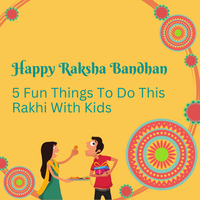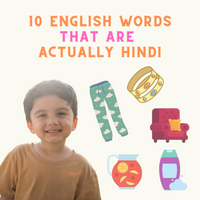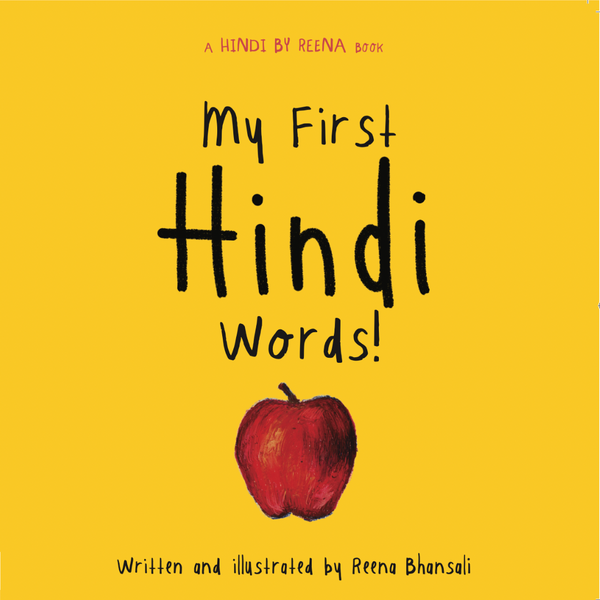After 10 years of research, here are 5 Hindi-learning tricks and 1 mistake to avoid at all costs
1. Your Goal Doesn’t Have to be 100% Fluency – Celebrate your Small Wins
Setting your goals too high when teaching your child Hindi can be very intimidating and frustrating.
But you don’t always have to have the “100% fluency” goal. Start small and build up from there.
Your goals can also be:
1. I know a few words and phrases
2. I can talk to my family
3. I can get by
Remember, your child can learn faster in small increments and with words of encouragement it’s never too late to learn. Celebrate their small wins, they will more likely be excited to learn more and have fun!
2. Use hand gestures to teach Hindi words!
When you are at the beginning of the journey to teach your kids Hindi, you don’t have to jump right into sentences or even phrases.
Actions speak louder than words. When you associate actions/movements to learn something new, you can learn faster.
This way, you can use Hindi words and NOT have to translate it into English. Your tone and hands say it all.
Here are 6 gestures to try right now!
1. Thora Sa – a little
Bringing your thumb and index finger closer to indicate something small.
2. Bahut - a lot
Facing your hands in front of each other – almost shoulder width apart, to show something big.
3. Jaldi – Fast
Spinning your hand in a quick motion.
4. Dheere – Slow
Similar to signalling “stop”, palm facing towards the person, but in a slow, repetitive movement.
5. Aao – Come
Palm facing up and then fingers moving towards you.
6. Ruko – Stop
A simple hand facing towards them, indicating to stop.
3. Hinglish can help your kids to learn Hindi Faster!
It’s never too late to teach your child Hindi, even if your child ONLY speaks English right now — here’s an easy tip to get them started with Hindi/Urdu.
You can use English and mix it with Hindi, so they understand the crux of it.
Then you can teach them easy responses.
Here are some examples:
Statement/question: Aapka Pink Bow kitna sundar hai
Teach them to respond with: Shukriya
Statement/question: Lunch ke liye Pasta chahiye ya daal?
Teach them to respond with:
1. Mujhe pasta chahiye
2. Mujhe daal chahiye
If people are having Hindi/Urdu conversations around them – Hinglish is a great way to include them.
4. You don’t always have to speak TO your child in Hindi (phew!), you can also speak around them
When teaching your child a new language— the standard advice is often to speak to your child in that language.
We tell our own parents — only talk to the grandkids in Hindi! And we strive to do the same.
While this is effective— it can be hard to do in practice. It can be awkward coming up with what to say and when to say things.
Instead, let’s take a little pressure off and speak in Hindi/ target language AROUND your child.
Call your parents and have a conversation with them. Are your grandparents in town? Seat your child in the room with them and give them a coloring book.
Have your kids listen to the language and learn that way. They’ll probably learn a larger variety of words too!
Encourage the eavesdropping!
5. In the beginning, NEVER correct your child's pronunciation
Never correct your child’s Hindi pronunciation, if you can understand them, that is enough! Yes, I said that, scary right? But here’s why.
Motivation is everything! Too many times I have seen families over-correct their child, emphasizing the correct “th” it should be, or the right “d” they should use — and sadly, all it does is demotivate and discourage their child from trying.
Suddenly Hindi becomes intimidating and there are tears whenever the subject is approached.
Instead, if your child mispronounces a word, AND you understand them, just congratulate them and move on! It’s almost like they’re babies again, learning new sounds and new words. They’ll start to pronounce things correctly with practice and exposure. Just give it time!
6. Feeling & experiencing words can accelerate learning Hindi
Try to avoid translating Hindi words too much. Keep it simple and use touch to reiterate what you mean.
For example:
Garam - Hot coffee
Thanda – Cold drink or ice
It can be as simple as giving them ice to touch and saying Thanda.
No need to explain anything more. Their brain will figure out that it’s cold.
Here are a few more fun words:
Geela – Wet
Hawa – A wind blowing or a fan
Jaldi - when they are walking fast or running
Meetha - when something is sweet
Khatta - when they eat something sour






